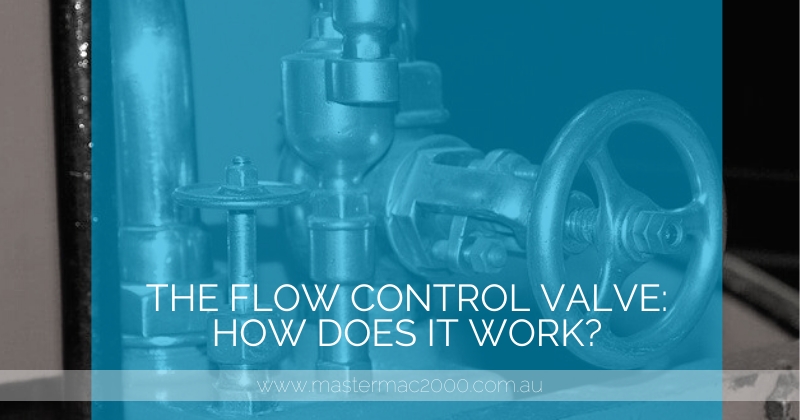The Flow Control Valve: How Does It Work?

A control valve is used to regulate the flow of fluids by changing its flow size or direction as directed by the signal from a controller. It directly helps in controlling any flow rate and in regulating other vital processes or their quantities such as temperature, liquid level, liquid flow, and pressure. In automatic control terminology, a flow control valve is referred to as a final control element.
Thus, a flow control valve is used to control the flow, pressure, liquid level, and temperature of any system by partially or completely opening or closing it based on all signals received by the controllers. Any electric, hydraulic, or pneumatic actuators attached to the pneumatic valves automatically controls the opening and closing of the control valve while the positioners control the opening and closing of the actuators.
How does a flow control valve work?
Take, for instance, a water processing plant that comprises numerous control loops to deliver consistently on the water supply. These so-called control loops have a set pressure, temperature, and flow level to maintain the required operating range. Each of these control loops can also experience any number of internal disturbances, and these disturbances can be measured by sensors and transmitters. The information collected can then be processed by the controllers to decide what can be done to rectify these disturbances. The information collected can also be analysed, measured, compared, and calculated for a controlling element to be implemented. This is when the flow control valve takes over to work and reduce these disturbances.
Therefore, a flow control valve working principle revolves around the manipulation of – in the case of this example – the flow of water. It can also be the manipulation of other flowing fluids like chemical compounds, or the flow of gas or steam. The valve ensures minimising of the load disturbance and regulating the process variable to the closest value of the desired set point.
Working Categorisation
Valves are actually broadly classified as linear or rotary type. But based on its internal movement and types of service, flow control valves can be categorised as follows:
For On and Off – Gate, Diaphragm Ball, Plug, Butterfly valves
For Throttling – Globe, Diaphragm, Butterfly, Pinch
For Non-Reverse Flow – Check valves
The Valves from Master Mac 2000
Diaphragm Valves
This type of valve is used for corrosive fluids under low temperature and pressure conditions. The diaphragm valve will vary the resistance of any liquid flow by deforming one surface by the force from the valve stem.
Plugging or Blocking Valves
This type of valve comprises a plug, body, and cover and is used for on-off services for industries such as refineries, chemicals manufacturing, and petrochemicals. Generally small in size, it requires less headroom and is available in a wide range of materials. The valve provides tight shutoff, quick opening, and low-pressure drop.
Ball Valves
This valve type is used to control the pressure and flow of corrosive fluids, normal liquids, and gasses, and slurries. It can also regulate high temperature and pressure.
If your company requires pneumatic valves, flow control valve, pneumatic tools, and process equipment, the top specialist in Australia is Master Mac 2000. Since 1989, this Australian-owned company has grown to become one of the country’s largest privately-owned process valve and pneumatic component distributors. To get help or advice for your industry needs, or for your queries, visit the Master Mac 2000 website at https://mastermac2000.com.au/.

About MasterMac2000: Your Trusted Pneumatic & Process Automation Partner.
LEADING THE INDUSTRY: Established in 1989, MasterMac2000 has grown to become one of Australia's largest privately owned pneumatic and process automation companies. We stock top-quality brands like Univer, Mack, Tolomatic, Mac, Piab, American, and Rotoflux in Brisbane.
SERVING QLD & NORTHERN NSW: We proudly service Queensland and Northern New South Wales for all your pneumatic and process equipment needs. Our mission is to provide the best pre and post-sales support while actively expanding our client base.
SOURCING HARD-TO-FIND PARTS: Not only do we stock quality components, but we also excel at sourcing those elusive, hard-to-find parts. With our extensive database and global network of contacts, getting the parts you require is as easy as a call to our highly skilled, professional sales team.
DEDICATED TO YOUR SUCCESS:
- Decades of expertise in pneumatics & process automation
- Carefully curated selection of world-class brands
- Exceptional sourcing capabilities for speciality parts
- Knowledgeable sales staff dedicated to finding solutions
- Unwavering commitment to customer service excellence
About The Author
Stuart Havill
Stuart Havill is the owner and manager of MasterMac2000, Queensland's largest privately owned pneumatic and process valve company.
With his early working career as a maintenance fitter for Boral in 1992, Stuart has spent his life in the field of pneumatics and process equipment. He gained extensive experience in plant design, maintenance, repairs, fabrication, and site management.
In 1996, he transitioned to a pneumatic sales technician role at MasterMac2000, where he excelled in key account management, providing cost-effective solutions, and managing a sales team of 9 employees.
Since 2002, Stuart has been the manager at MasterMac2000, overseeing the company's growth and establishing it as a leader in pneumatic automation and process valve engineering. His expertise spans customer training, CRM setup, industrial compressor sizing and installation, and turn-key project management.
Under Stuart's leadership, MasterMac2000 has been servicing the industry since 1988, with 5 full-time sales representatives covering northern rivers NSW, Queensland, Northern Territory, and PNG. The company prides itself on providing the best-priced solutions to all customers in the marketplace.
View Stuart’s LinkedIn profile to learn more about his expertise in pneumatics and process equipment.